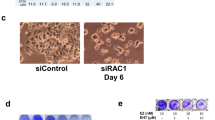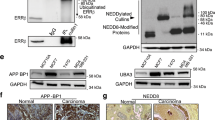Abstract
The BRCA1 gene was previously found to inhibit the transcriptional activity of the estrogen receptor [ER-α] in human breast and prostate cancer cell lines. In this study, we found that breast cancer-associated mutations of BRCA1 abolish or reduce its ability to inhibit ER-α activity and that domains within the amino- and carboxyl-termini of the BRCA1 protein are required for the inhibition. BRCA1 inhibition of ER-α activity was demonstrated under conditions in which a BRCA1 transgene was transiently or stably over-expressed in cell lines with endogenous wild-type BRCA1 and in a breast cancer cell line that lacks endogenous functional BRCA1 (HCC1937). In addition, BRCA1 blocked the expression of two endogenous estrogen-regulated gene products in human breast cancer cells: pS2 and cathepsin D. The BRCA1 protein was found to associate with ER-α in vivo and to bind to ER-α in vitro, by an estrogen-independent interaction that mapped to the amino-terminal region of BRCA1 (ca. amino acid 1-300) and the conserved carboxyl-terminal activation function [AF-2] domain of ER-α. Furthermore, several truncated BRCA1 proteins containing the amino-terminal ER-α binding region blocked the ability of the full-length BRCA1 protein to inhibit ER-α activity. Our findings suggest that the amino-terminus of BRCA1 interacts with ER-α, while the carboxyl-terminus of BRCA1 may function as a transcriptional repression domain.
This is a preview of subscription content, access via your institution
Access options
Subscribe to this journal
Receive 50 print issues and online access
$259.00 per year
only $5.18 per issue
Buy this article
- Purchase on Springer Link
- Instant access to full article PDF
Prices may be subject to local taxes which are calculated during checkout





Similar content being viewed by others
References
Chapman MS and Verma IM. . 1996 Nature 382: 678–679.
Chen Y, Lee WH and Chew HK. . 1999 J. Cell. Physiol. 181: 385–392.
Chlebowski RT. . 2000 N. Engl. J. Med. 343: 191–198.
Dignam JD, Lebovitz RM and Roeder RG. . 1983 Nucleic Acids Res. 5: 1475–1489.
Fan S, Wang J-A, Meng Q, Yuan R-Q, Ma YX, Erdos MR, Pestell RG, Yuan F, Auborn KJ, Goldberg ID and Rosen EM. . 1999 Science 284: 1354–1356.
Fan S, Wang J-A, Yuan R-Q, Ma YX, Meng Q, Goldberg ID and Rosen EM. . 1998 Oncogene 16: 3069–3083.
Faust PL, Kornfeld S and Chirgwin JM. . 1985 Proc. Natl. Acad. Sci. USA 82: 4910–4914.
Ford D, Easton DF, Bishop DT, Narod SA and Goldgar DE. . 1994 Lancet 343: 692–695.
Friedman LS, Ostermeyer EA, Szabo CI, Dowd P, Lynch ED, Rowell SE and King MC. . 1994 Nat. Genet. 8: 399–404.
Henttu PMA, Kalkhoven E and Parker MG. . 1998 Mol. Cell. Biol. 17: 1832–1839.
Jeltsch JM, Robers C, Shatz JM, Garnier JM, Brown AM and Chambon P. . 1987 Nucleic Acids Res. 15: 1401–1414.
Loman N, Johannsson O, Bendahl PO, Borg A, Ferno M and Olsson H. . 1998 Cancer 83: 310–319.
Miki Y, Swensen J, Shattuck-Eidens D, Futreal PA, Harshman K, Tavtigian S, Liu Q, Cichran C, Bennett LM, Ding W. . 1994 Science 266: 66–71.
Monteiro AN, August A and Hanafusa H. . 1996 Proc. Natl. Acad. Sci. USA 93: 13595–13599.
Streuwing JP, Hartge P, Wacholder S, Baker SM, Berlin M, McAdams M, Timmerman MM, Brody LC and Tucker MA. . 1997 New Engl. J. Med. 336: 1401–1408.
Tirkonnen M, Johannson O, Agnarsson BA, Olsson H, Ingvar-sson S, Karbu R, Tanner M, Isola J, Barkardottir RB, Borg A and Kallioniemi OP. . 1997 Cancer Res. 57: 1222–1227.
Wang CY, Petryniak B, Thompson CB, Kaelin WG and Leiden JM. . 1993 Science 260: 1330–1335.
Webb P, Nguyen P, Shinsako J, Anderson C, Feng W, Nguyen MP, Chen D, Huang SM, Subramanian S, McKinerney E, Katzenellenbogen BS, Stallcup MR and Kushner PJ. . 1998 Mol. Endocrinol. 12: 1605–1618.
Webber MM, Bello D and Quader S. . 1997 Prostate 30: 58–64.
Yarden RI and Brody LC. . 1999 BRCA1 interacts with components of the histone deacetylase complex Proc. Natl. Acad. Sci. USA 96: 4893–4988.
Yu X, Wu LC, Bowcock AM, Aronheim A and Baer R. . 1998 J. Biol. Chem. 273: 25388–25392.
Acknowledgements
Supported, in part, by USPHS grants R01-ES09169, R01-82599, and RO1-80000 (EMR.), the Elsa U Pardee Cancer Foundation of Michigan (EMR), the New York State Department of Health (EMR), US Army Breast Cancer grant DAMD17-99-1-9254 (EM Rosen), the Susan G. Komen Breast Cancer Foundation (RG Pestell), and USPHS grants RO1-CA75503 and R01-CA70897 (RG Pestell).
Author information
Authors and Affiliations
Rights and permissions
About this article
Cite this article
Fan, S., Ma, Y., Wang, C. et al. Role of direct interaction in BRCA1 inhibition of estrogen receptor activity. Oncogene 20, 77–87 (2001). https://doi.org/10.1038/sj.onc.1204073
Received:
Revised:
Accepted:
Published:
Issue Date:
DOI: https://doi.org/10.1038/sj.onc.1204073
Keywords
This article is cited by
-
The role of epigenetic modifications in drug resistance and treatment of breast cancer
Cellular & Molecular Biology Letters (2022)
-
High BRCA1 gene expression increases the risk of early distant metastasis in ER+ breast cancers
Scientific Reports (2022)
-
CODA-ML: context-specific biological knowledge representation for systemic physiology analysis
BMC Bioinformatics (2019)
-
Trans-activation-based risk assessment of BRCA1 BRCT variants with unknown clinical significance
Human Genomics (2018)
-
BRCA1-mimetic compound NSC35446.HCl inhibits IKKB expression by reducing estrogen receptor-α occupancy in the IKKB promoter and inhibits NF-κB activity in antiestrogen-resistant human breast cancer cells
Breast Cancer Research and Treatment (2017)



